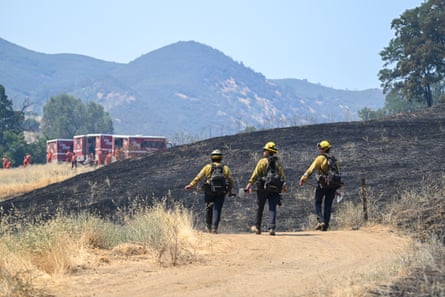A wildfire in Oregon has grown so large that it is creating its own weather, experts have said.
The so-called Durkee fire was sparked by lightning and has since grown to nearly 240,000 acres (97,124 hectares). The fire is threatening homes in and around the communities of Durkee, Huntington and Rye Valley, as well as a major highway, cell towers and power infrastructure in the area.
Stephen Parker, a meteorologist with the National Weather Service in Boise, Idaho, said the Durkee fire showed such extreme fire behavior on Saturday, Sunday and Monday that it began creating its own weather system with a “pyrocumulus cloud”.
“That can happen when a fire becomes plume-dominated,” Parker said. “It’s like a thunderstorm on top of the fire, generated by the heat of the fire.”
The pyrocumulus cloud allows the smoke and ash from the fire to travel much higher in the air than it would typically go, he said. If there is enough moisture in the air above the fire, the pyrocumulus cloud can also generate rain and lightning, potentially causing new fire starts in the region.
There were lightning strikes in the region on Monday night, but there were also other thunderstorms in the area, making it impossible to tell which weather system was responsible for the storm, Parker said.
The Durkee fire is among dozens of wildfires burning across states in the US west including Oregon, California and Utah. Western states have also spent weeks in the grip of back-to-back heatwaves, some with record-breaking triple-digit temperatures, compounding the risk of new ignitions and creating challenging conditions for firefighters.
Wildfires are also raging north of the border in Canada, forcing the evacuation of one of the country’s largest national parks.

The Pacific north-west has already seen a particularly aggressive fire season. Multiple fires have scorched more than 1,093 sq miles (2,830 sq km) in Oregon, with nearly 180 sq miles (466 sq km) torched in the past 24 hours, authorities said.
In central Washington, a fire that sparked Monday near the town of Naches prompted mandatory evacuations, while another near the town of Bickleton also forced evacuations and threatened a natural gas plant.
“This is shaping up to be another monster fire year in the Pacific north-west, and it’s just mid-July,” Ed Hiatt, the Pacific north-west assistant fire director for operations at the US Forest Service, said on Tuesday in a news release.
Millions of acres of national forest lands across Oregon and Washington are continuing to see record-breaking dry timber conditions, exacerbated by a lack of rainfall, according to the news release.
Oregon governor Tina Kotek earlier this month declared an “extended state of emergency” until October because of the increased risk of wildfires.
Elsewhere, a series of lightning-sparked wildfires near the California-Nevada border forced the evacuation of a recreation area, closed a state highway and threatened structures on Tuesday. Nearly 200 children and staff at a summer camp near Portola, a town about 50 miles (80km) north-west of Reno, were evacuated.
Heatwaves and historic drought tied to climate change have made wildfires more challenging to fight in the American west. Scientists have said climate change has made the region much warmer and drier in the past 30 years and will continue to make the weather more extreme, and wildfires more frequent and destructive.
Read more on wildfires in the US west and Canada
Large-scale and intense wildfires carrying smoke across northern hemisphere
Canada wildfires: 25,000 evacuate Jasper national park amid multiple blazes
US government urged to declare wildfire smoke and extreme heat major disasters
California wildfires have burned five times the average area this year, officials say